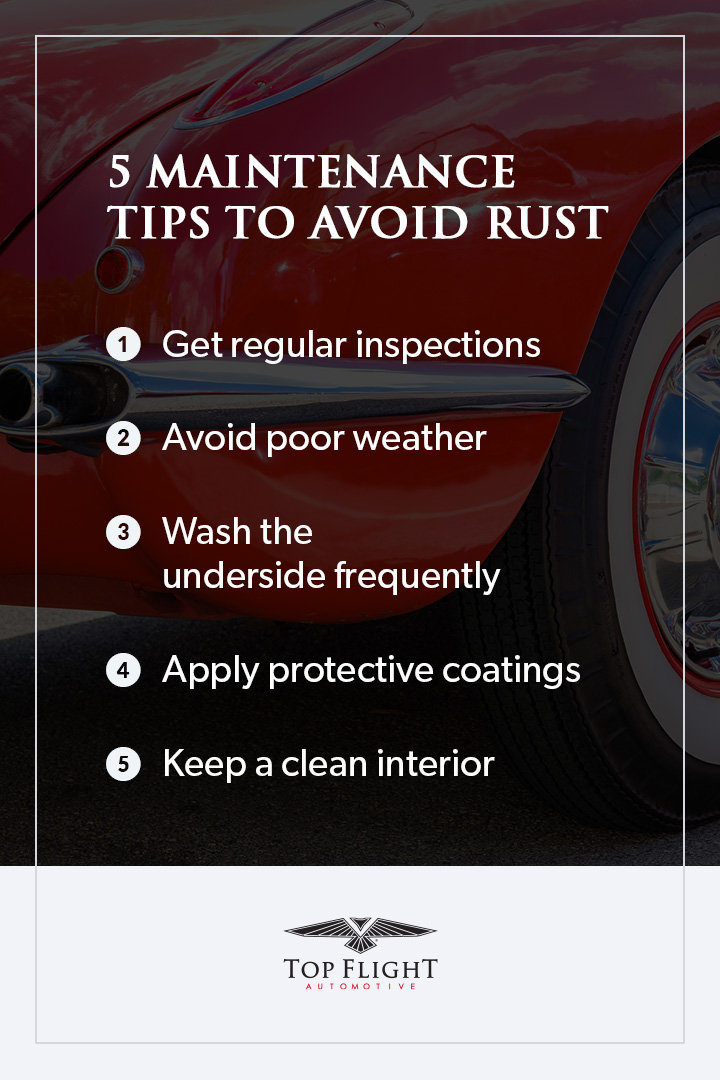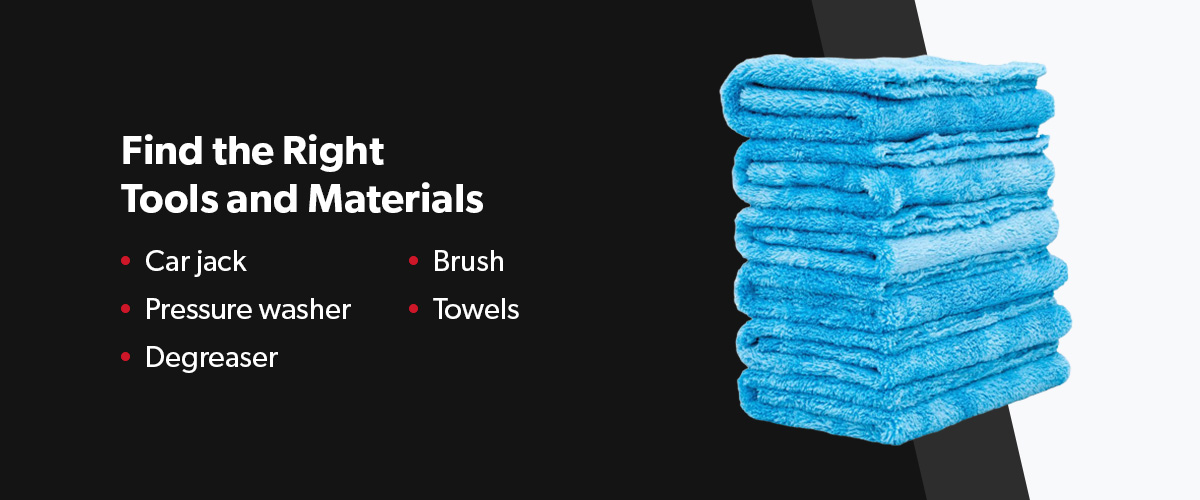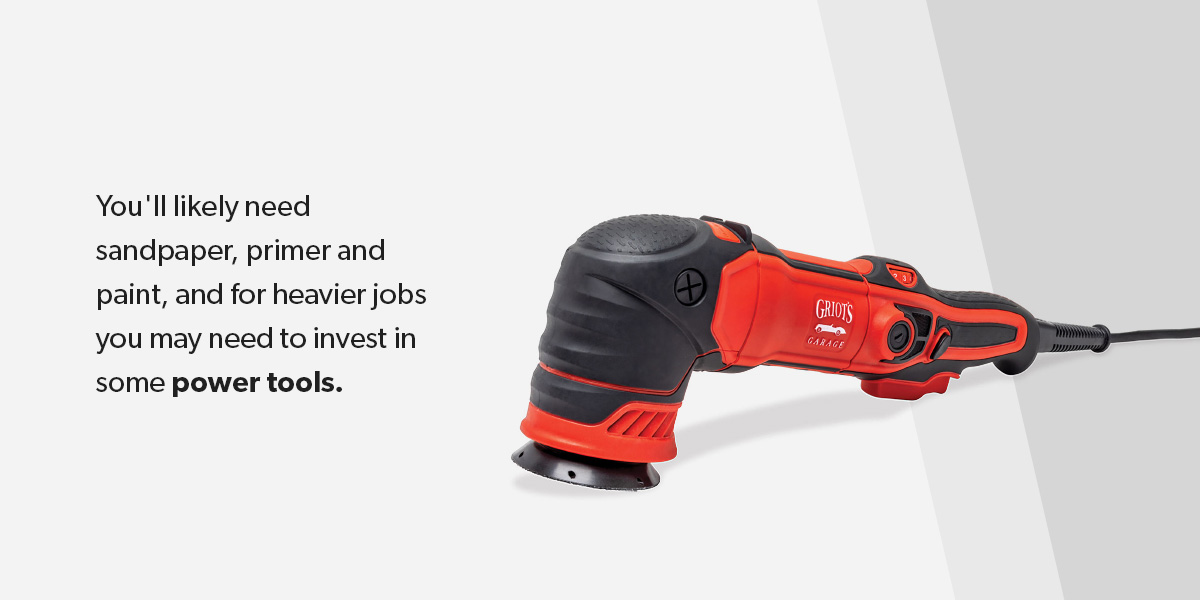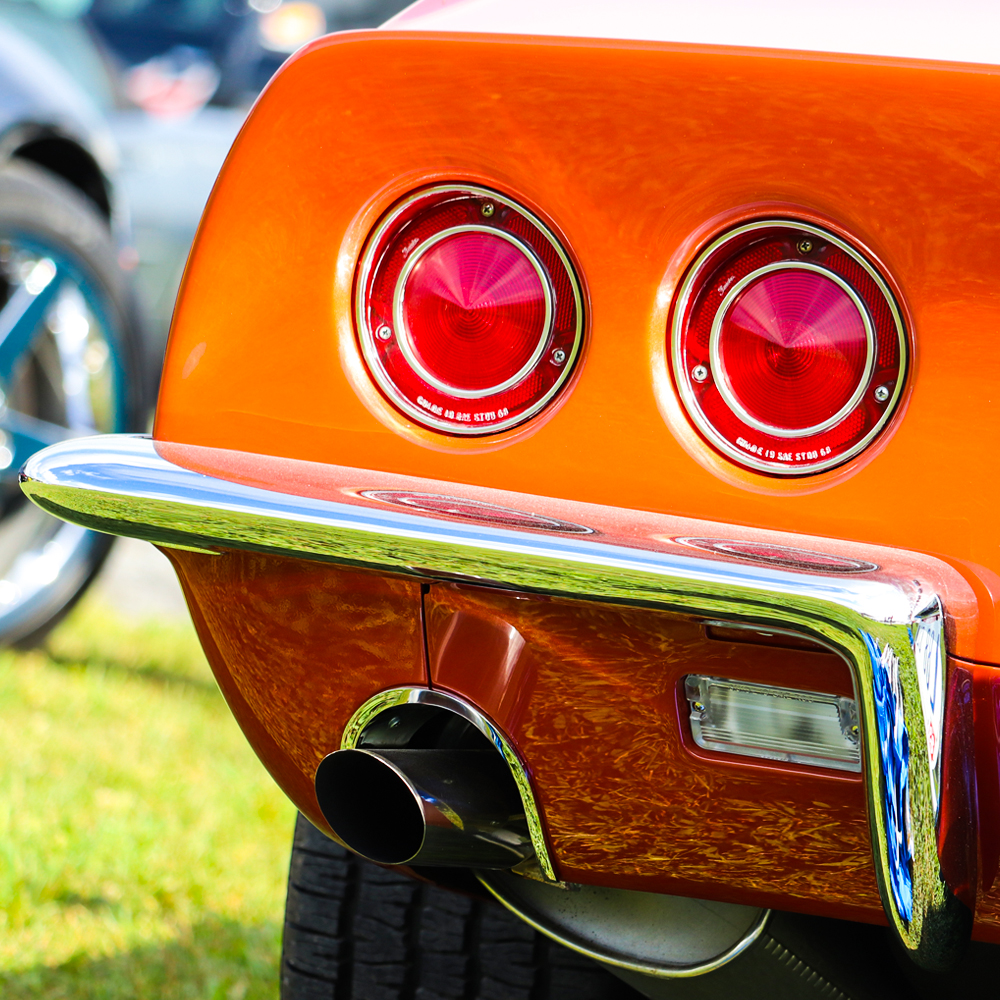
A vintage Corvette is a treasured vehicle and a symbol of the peak of auto manufacturing. With its history, attractive appearance and amazing functionality, you might be wondering how you can protect it from wearing down.
Rust is one of the most troublesome aspects vintage car owners deal with. Corvette exteriors consist of fiberglass, a material that cannot rust. But despite Corvettes’ reputation as rust-free cars due to their fiberglass body panels, the cars can still develop rust in other areas, including underside components like wheel wells, frame rails and exhaust systems. Some owners are unaware of these hazards or are unsure of how to remove the rust once it appears.
It’s important to understand the causes of rust, where rust usually grows and the various tips to help prevent and get rid of it. With a little bit of information, you can effectively protect your vintage Corvette from the dangers of rust.
What Causes Rust on Cars?
In a process called oxidation, moisture reacts with the iron on your vehicle to create rust. Even with innovative new materials, there is still a chance that rust can form on the underside of your vintage Corvette. Be sure you’re paying attention to the various causes so you can plan to avoid or deal with them.
Salt and lack of maintenance can be factors that contribute to rust. Usually, it’s a combination of these components:
- Salt: One of the most well-known causes of rust and general wear is salt, which can speed up the rusting process. If you live in a colder climate, you may want to think twice about driving your vintage Corvette out in the winter. Those salty roads could wreak havoc on your vehicle.
- Mud: Dirt and moisture can be damaging to your Corvette, though it’s small enough that sometimes it won’t do any damage. Mud, on the other hand, can get stuck onto the underside of your vehicle, trapping moisture and dirt and leading to the easy growth of rust.
- Mice: Many people forget the dangers that small rodents like mice present — these animals love to nest in the frames of your vehicle. If you have your vintage Corvette in storage, this is something to keep an eye on.
Where Do Corvettes Typically Rust?
Corvettes tend to rust on the underside components — wheel wells, frame rails, exhaust and suspension. This is because the underside of your Corvette is exposed to contaminants on the road like salt and moisture, which can easily get to your vehicle and start to chemically react.
Likewise, it can also be more challenging to get under your vehicle for a good wash. Many people neglect the undercarriage of their vehicle during maintenance simply because it’s hard to get to. Lacking washes will result in car frame rust.

5 Maintenance Tips to Avoid Rust
As you read through the facts about rust, it can start to seem like it’s inevitable. The truth is, you can integrate a few easy steps that can be very effective in preventing rust on your vintage Corvette. Follow these maintenance tips to avoid rust.
1. Get Regular Inspections
Frequent, regularly-scheduled inspections are one of the best ways to protect your vintage Corvette from rust. Inspections will help you figure out what’s going on with your vehicle — not just on the apparent exterior or the interior, but also underneath the wheel wells and frame rails.
2. Avoid Poor Weather
Climate has a huge impact on the wellness of your vintage Corvette. Cold climates with snow, rain and salted roads can create the factors needed for rust to grow. If you can, try to avoid driving in these conditions. If you do, make sure you’re investing in protective coatings and regular washing. Inspect your vehicle frequently to defend against the ill effects of poor weather.
3. Wash the Underside Frequently
Wash the underside of your vintage Corvette often to get rid of contaminants. One of the primary reasons rust can grow on your vehicle is because of lingering grime and salt that builds up underneath. A simple wash can get rid of a lot of that dirt and ensure that your Corvette is protected.
4. Keep a Clean Interior
Your interior might seem like a strange place to focus on when it comes to preventing rust. Sometimes your interior can become the breeding ground for rust — a spilled drink can leak down into the foundation of your vehicle, creating moisture and beginning the oxidation process. Make sure you’re being careful about what you bring into your vehicle. When you clean your vintage Corvette, get into the interior as well to inspect for spills.
Figuring out how to prevent rust on cars can be a challenge. These vintage Corvette maintenance tips will help you take actionable steps toward protecting your vehicle.
How to Wash the Underside of Your Car to Avoid Rust
Your Corvette’s underside is the most likely place that will develop rust. By washing it regularly, you can prevent the build-up of dirt, grime and salt. However, many people may be unsure of the right way to clean underneath. The cleaning process requires specific materials and methods. You can always contact professionals to complete the cleaning if you don’t have the right tools.
These are basic steps you can follow for cleaning the underside of your Corvette:
1. Find the Right Tools and Materials
Before you start cleaning, you should shop for what you need. You might not have some tools and materials readily available, so you need to seek them out beforehand. This includes tools like:
- Car jack
- Pressure washer
- Degreaser
- Brush
- Towels
It’s helpful to find one convenient place to get all of your materials. Finding that one trusted location will ensure you’re getting the quality you need.

2. Use a Car Jack to Lift Your Corvette
Once you’ve got the products you need for washing your vintage Corvette, it’s time to lift the vehicle. Raising it allows you to access the hard-to-reach areas and deliver a thorough clean. If it’s not elevated, excess rocks and dirt can make a significant mess in your garage or whatever area you use to clean.
Use the car jack to lift your Corvette into a higher position. You can pump the handle until you reach your desired height.
3. Wash With a Pressure Washer
It’s best to pressure wash your car’s underside. The pressure can loosen contaminants in all areas of the car, even ones that are lodged tightly within the components. It’s often most effective to rinse it one section at a time. That way, you can make sure you address every part of the undercarriage.
4. Treat Parts With a Degreaser
When you’re finished washing your vintage Corvette with the pressure washer, you can treat parts with a degreaser. Some engine parts and electric parts can become oily after use. A degreaser can cut through the grease and leave the parts in better condition. Let it sit for at least twenty minutes to ensure it sinks in.
There are many kinds of degreasers available, and you can select the option that best suits your needs. For instance, you might choose a heavy-duty degreaser if you know your vintage Corvette needs a thorough cleanse, while a preventative approach may be better for newer or cleaner vehicles.
5. Let the Underside Dry
Drying is one of the most important aspects of the cleaning process. Many people may find it easy to neglect this last step. Leaving it moist can cause rust to form, which would detract from your prior actions. When you’re done washing, make sure the underside becomes completely dry. You can use towels or a blow dryer to remove any remaining moisture.
6. Apply a Protective Layer
If you’d like, you could also add a protective coating to your Corvette’s underside. Protectants can shield your vehicle from moisture, salt, dirt, rocks and other materials. Just make sure you’re finding trusted products that are okay to use on your vehicle.
How to Remove Rust From a Vintage Corvette
While preventing rust from forming on your vintage Corvette is a great practice, you may already be past the point of prevention. Whether you’ve bought a vintage Corvette that already has rust or it’s formed under your ownership, don’t worry — there are still ways you can remove that rust and protect your Corvette from any more damage.
1. Assess the Scope of the Job
First, you need to assess the scope of the job. How bad is it? You should be able to put the scope of the job into one of three categories:
- Scale rust: This type of rust has had time to grow and expand across the metal of your vehicle, creating holes, pits and blisters on your exterior. To get rid of this type of rust, you’ll need some more advanced tools and a bit of time. In some cases, you may want to take it to an auto technician.
- Penetrating rust: Rust has been left untreated to an unhealthy degree, allowing the metal of your vehicle to begin to corrode and disintegrate severely. Treatment for penetrating rust is best left to a professional repair technician who can safely try to repair it to its original condition. In many cases, you may need to buy replacement parts for vehicles that have penetrating rust.
Identifying the scope of the job will help you determine your next steps. You may want to look into getting replacement parts and help from an experienced technician.
2. Find Products
Match the products you need to the scope of the job. You’ll likely need sandpaper, primer and paint, and for heavier jobs you may need to invest in some power tools. If you are looking at a more involved job, make sure you’re also investing in safety equipment such as safety goggles and gloves.

3. Mark Off Rust Spot
Identify the area of rust and mark it off with tape. Try to stay in this area while you work to avoid damage to other parts of your vehicle. If you want, you could cover the rest of your vehicle to defend against any rust particles and other contaminants while you work.
4. Remove Rust
Once you’ve prepared the area and gotten your materials and tools ready, it’s time to remove the rust. This will look different based on the scope of the job. For surface rust, you may be able to use sandpaper to remove those small bits from your exterior.
For scale rust, you might be using a grinder to get rid of big chunks. Once you’ve removed those larger pieces, you can go back in with a smaller tool and get rid of any lingering debris. The key is to ensure that you’ve removed all of the rust before moving on to the next step.
5. Wash
Use mild soap to wash and rinse the underside of your vintage Corvette. This will help get rid of any remaining rust particles and dirt from your vehicle. It will also let you see if they’re anything left that you need to clean. If there is, repeat the previous step and wash again. You might need to do this a few times to be thorough.

CHEVROLET CORVETTE
Find Products
Parts Not Able to Be Repaired? Find Replacements at Top Flight Automotive Shop All Products
Shop Online Today
Whether you’re looking to prevent rust on your vintage Corvette or looking to remove it, it’s important to find the right products and tools to help you throughout the process. At Top Flight Automotive, we offer you everything you need. With us, you’ll be experiencing multiple benefits, including:
- Convenience: Instead of working through various sellers to get what you’re looking for, Top Flight Automotive offers you a one-stop shop where you can find everything you’re looking for in one convenient online store. When you’re undertaking a complicated project, that convenience can be just the thing to set you on the right track.
- Quality: At Top Flight Automotive, we’re committed to giving our customers high-quality products. You’ll be able to rely on the products you buy for years to come.
- Experience: We have decades of experience in the Corvette industry. When you have questions about parts or the rust-removal process, our team is there to assist you. We can provide you with expert information that can make your rust-removal project go smoothly.
With advantages like convenience, quality and experience, Top Flight Automotive is your place for rust-removal products and tools. Browse our selection and talk to our sales team to find what you need. Shop online today!










Leave a Response